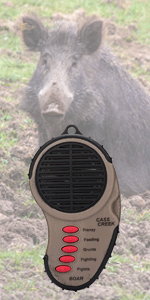Learn How to Electronic Hog Caller Work
An electronic hog caller, also known as an electronic game call or digital game call, is a hunting device designed to attract wild hogs by imitating their natural vocalizations. It operates on the principle of audio mimicry, replicating various hog sounds, such as grunts, squeals, and distress calls, to lure hogs within range of the hunter. To comprehend how these devices work, we’ll explore their components, functionality, sound selection, and overall operation in detail.

Components of an Electronic Hog Caller
An electronic hog caller typically consists of several key components that work together to create lifelike hog sounds:
a. Speaker
The speaker is the primary output component responsible for producing the hog calls. It is designed to emit sound at a loud volume to carry over long distances, allowing hunters to attract hogs from afar.
b. Sound Bank
The sound bank is a collection of pre-recorded hog sounds stored within the electronic hog caller. These sounds are often authentic recordings of real hog vocalizations, capturing various scenarios like mating calls, feeding grunts, or distressed piglets.
c. Control Panel
The control panel is the user interface of the electronic hog caller. It typically features buttons, switches, and sometimes an LCD screen. The hunter uses the control panel to select and activate different hog sounds, adjust volume levels, and operate additional functions.
d. Power Source
Electronic hog callers are powered by batteries, which can be either disposable or rechargeable. The power source ensures the device has sufficient energy to emit sounds for extended hunting sessions.
e. Remote Control (Optional)
Some electronic hog callers come with remote controls that enable hunters to operate the device from a distance. This feature allows hunters to set up the caller in one location and control it remotely while maintaining concealment.

Functionality of an Electronic Hog Caller
The functionality of an electronic hog caller is relatively straightforward. The hunter sets up the device in a strategic location where hogs are likely to be present. Once the hog caller is in position, the hunter activates it using the control panel or the remote control if applicable.
Upon activation, the electronic hog caller accesses the sound bank and starts playing the selected hog calls through the speaker. The emitted sounds imitate various hog vocalizations, attracting the attention of nearby hogs.
Sound Selection and Customization
Modern electronic hog callers offer a wide range of sound options to cater to different hunting scenarios. The sound bank may include calls for different hog species, ages, genders, and behaviors. For instance, there may be calls for attracting sows during the mating season, luring aggressive boars, or eliciting distress calls from piglets.
Hunters can customize their calling sequence by choosing specific sounds and even setting up sequences of different calls. This customization allows hunters to adapt their strategies to specific hunting conditions, increasing their chances of attracting hogs.
Operation in the Field
In the field, hunters position the electronic hog caller strategically to maximize its effectiveness. The device is often set up downwind from the hunter’s location to prevent the hogs from picking up the human scent. It is usually placed on a stable surface or elevated using a stand or tripod for better sound projection.
Before activating the hog caller, hunters ensure that they are in a concealed and safe location with a clear line of sight to potential approaching hogs. They activate the device and then patiently wait for the hogs to respond to the calls.

Effective Range and Sound Decoy
The effective range of an electronic hog caller varies depending on the specific model and environmental factors. Generally, these devices can produce sounds with a range of up to a few hundred yards, allowing hunters to attract hogs from a considerable distance.
The sound decoy aspect of the electronic hog caller is crucial to its effectiveness. Wild hogs are naturally curious and social animals, and they respond to the calls of other hogs. When they hear the hog calls emitted by the electronic caller, they may interpret it as a group of hogs nearby and be drawn to investigate, providing the hunter with a potential shot opportunity.
Advanced Features and Connectivity
Some electronic hog callers come equipped with advanced features to enhance their functionality and appeal to hunters. These features may include:
a. Wireless Connectivity
Certain models can connect to mobile devices via Bluetooth or Wi-Fi, allowing hunters to download additional sound files or control the caller using a dedicated smartphone app.
b. Decoy Integration
Some electronic callers can be synchronized with decoys, such as robotic hog decoys, to create a more realistic hunting setup. The combination of sound and visual attraction can be particularly effective in luring hogs.
c. Remote Control with Caller Distancing
As mentioned earlier, some electronic callers come with remote controls, enabling hunters to activate the device from a distance. Caller distancing can be advantageous when the hunter wants to maintain a separate position from the electronic hog caller to avoid spooking hogs.

Responsible and Ethical Use
While electronic hog callers can be valuable hunting tools, it’s essential for users to employ them responsibly and ethically. Hunters should follow all local hunting regulations and obtain proper permits when required. They must also prioritize safety, avoid over-hunting to protect hog populations, and be mindful of the impact on the environment and other wildlife.
Electronic hog callers are innovative hunting devices designed to mimic hog vocalizations and attract hogs for hunting purposes. They rely on a combination of well-designed speakers, a sound bank with authentic hog calls, and user-friendly controls to create an effective calling sequence.
